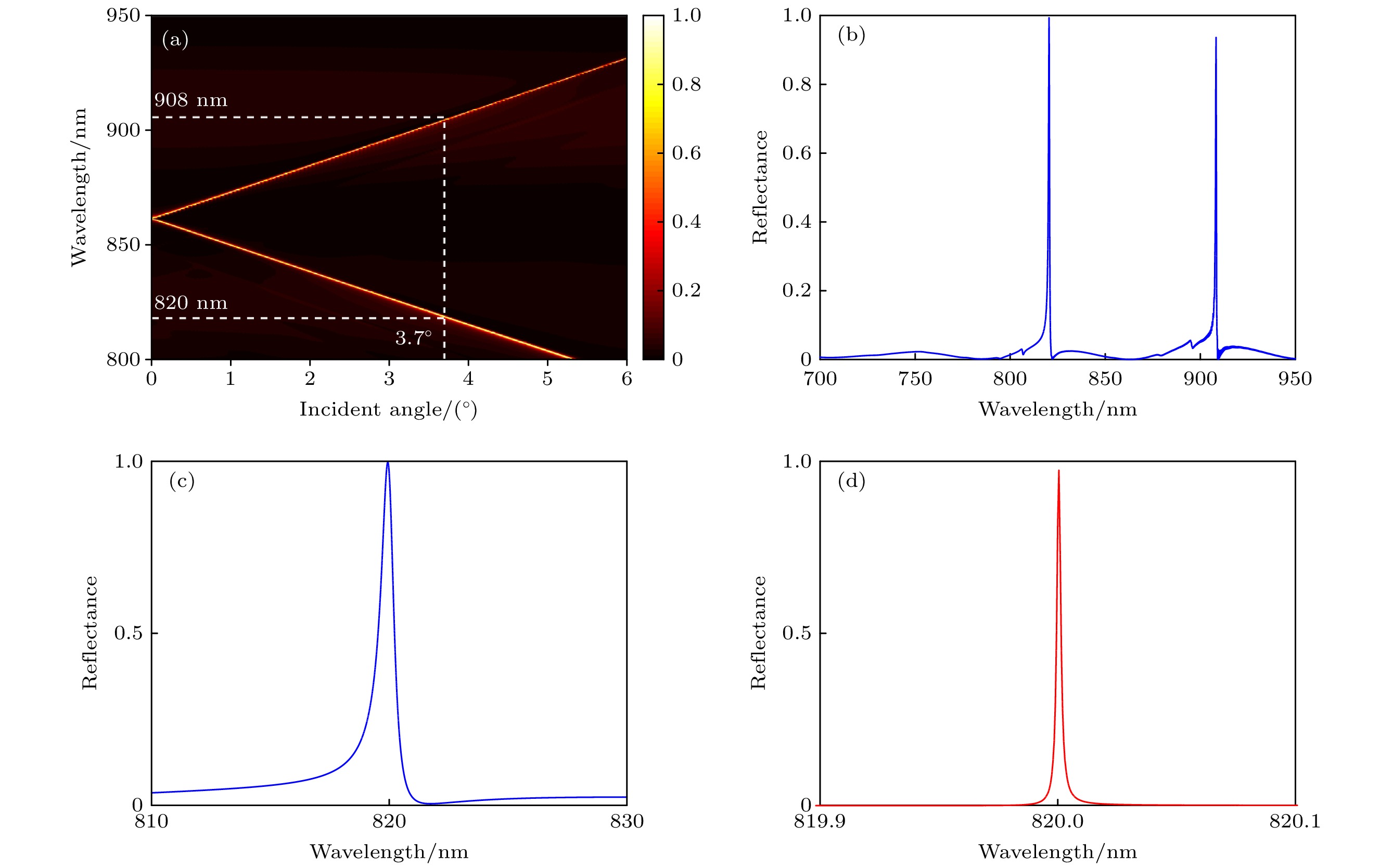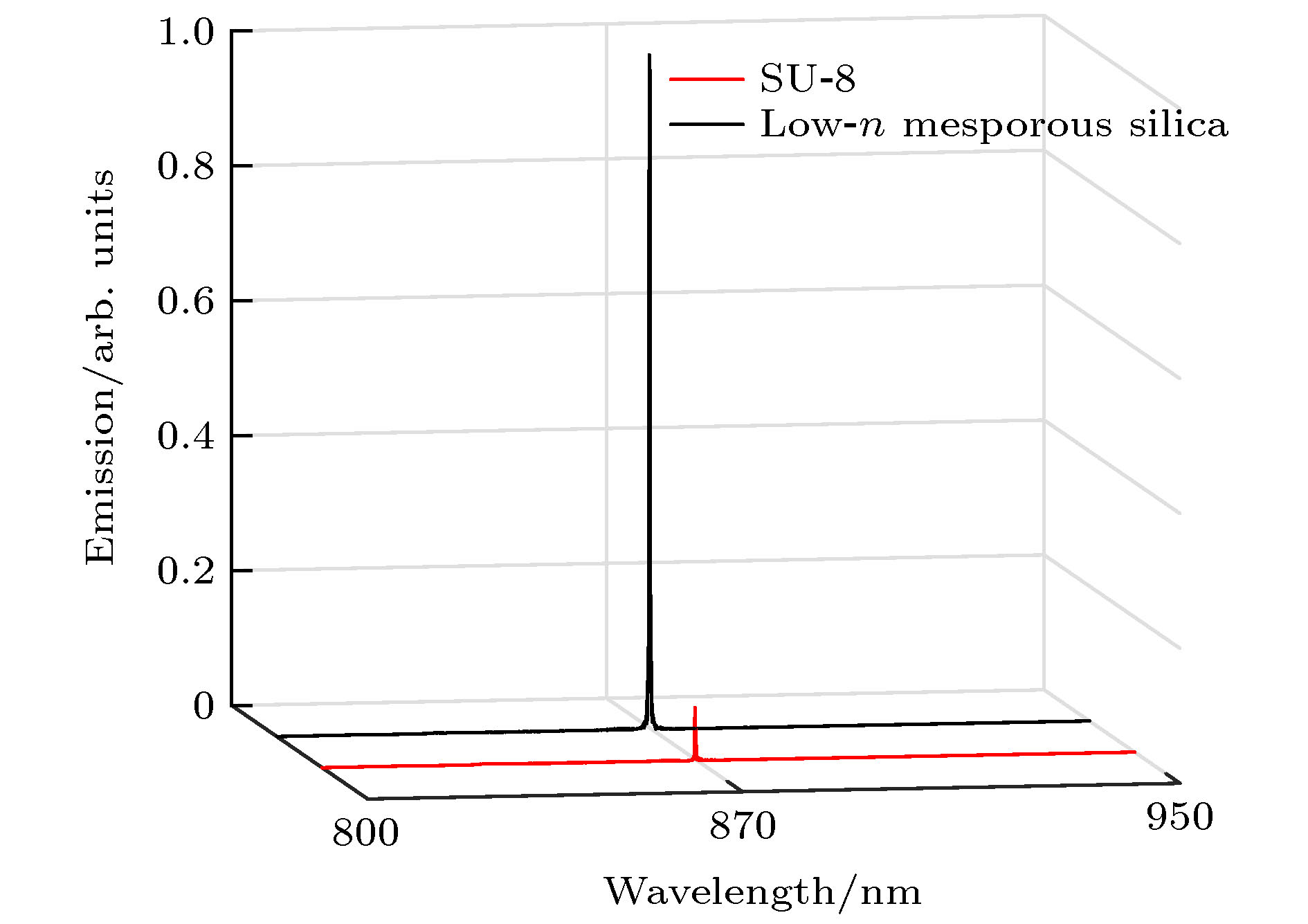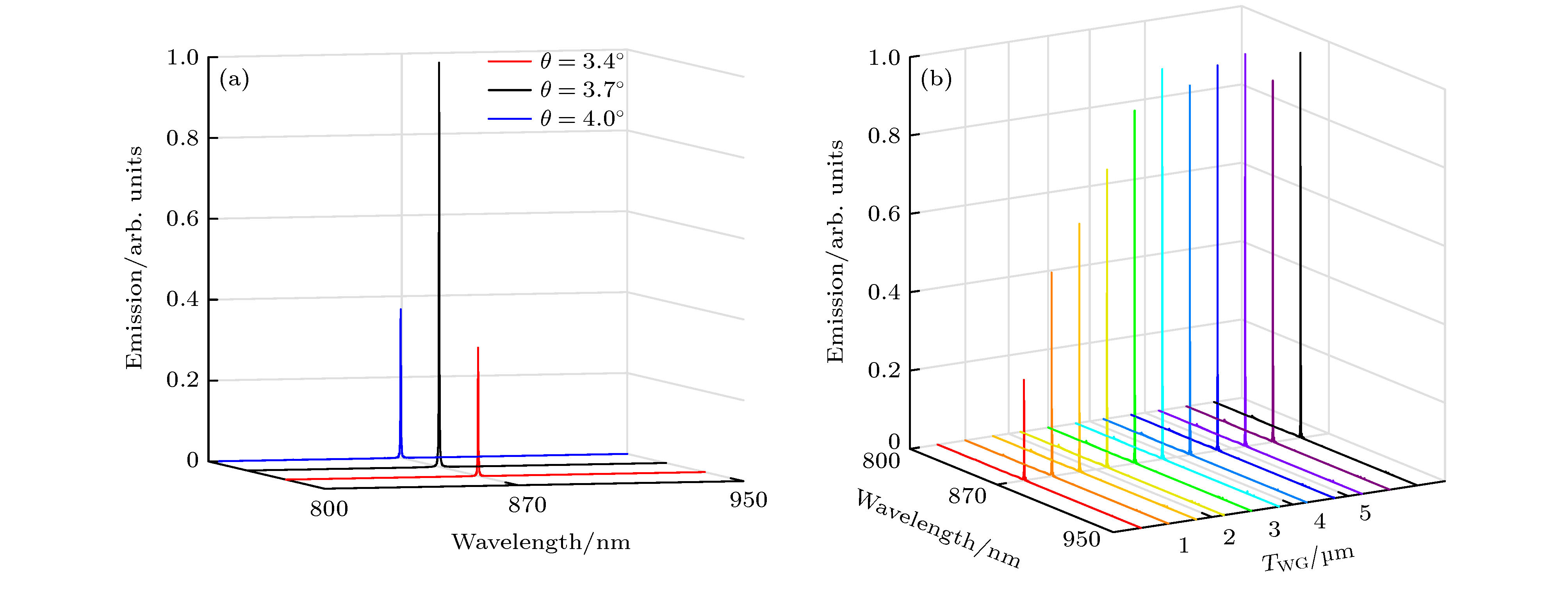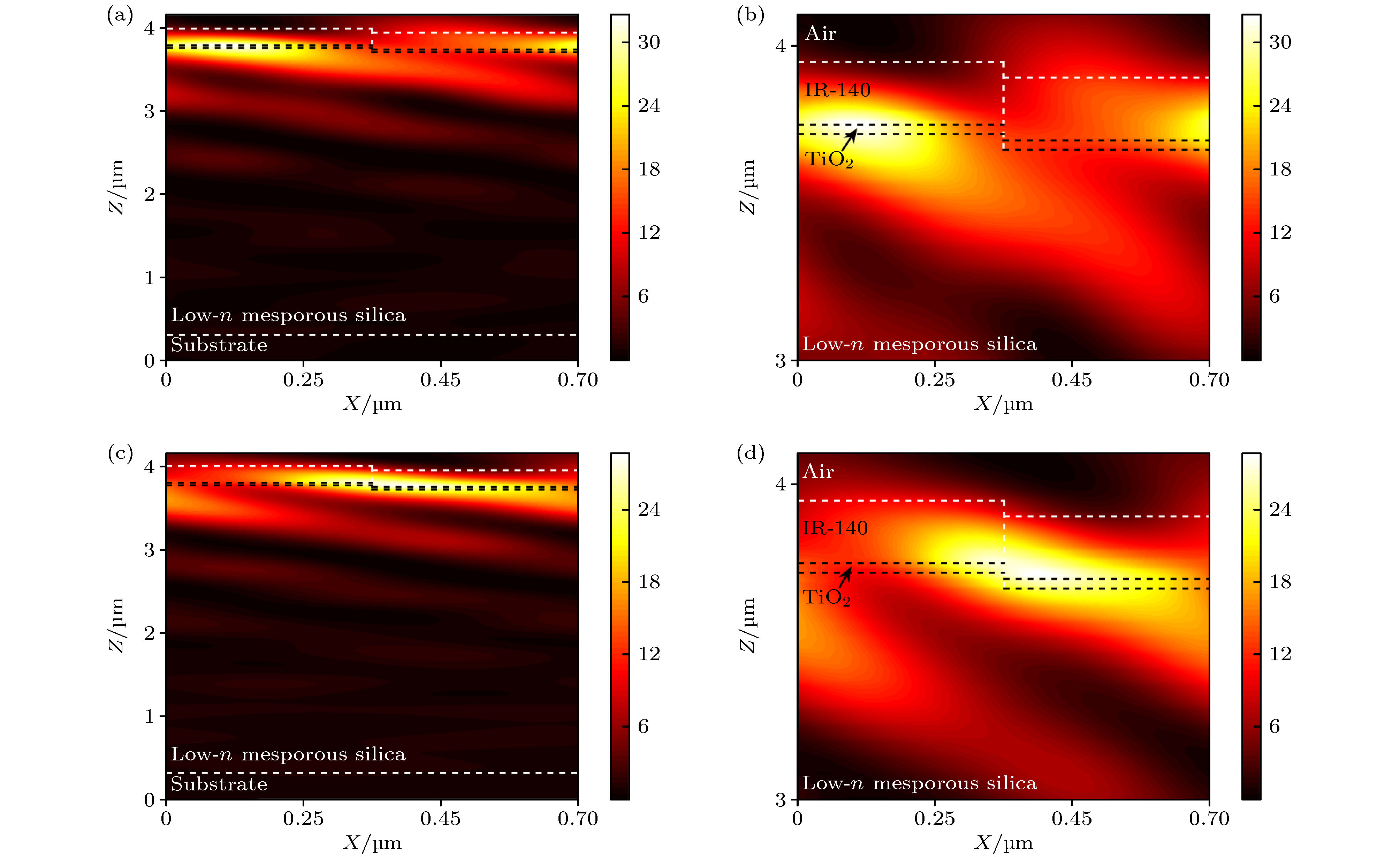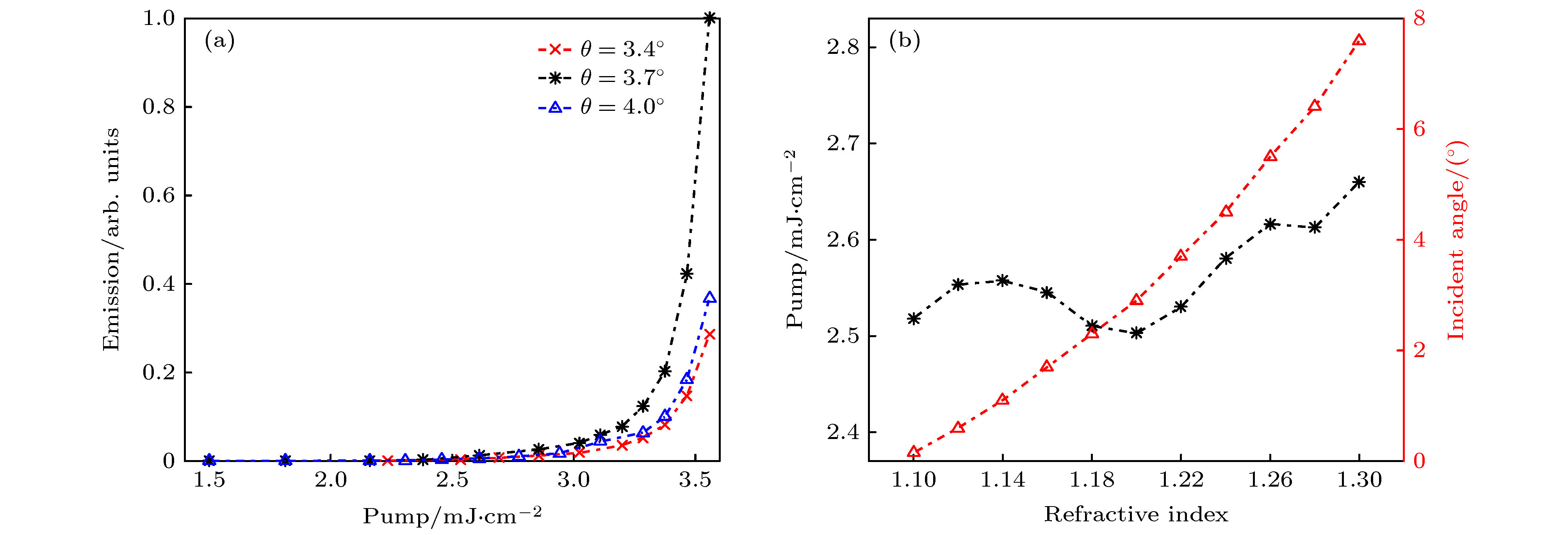-
导模共振光栅是一种典型的平面波导共振结构, 可在光栅表面或波导层内形成较强的局域电场, 能增强光与物质的相互作用. 本文在导模共振结构的光栅层和基底层之间, 引入低折射率的多孔二氧化硅间隔层, 显著增强了局域电场与增益介质的接触度. 结果表明, 引入多孔二氧化硅后, 共振产生的电场增强区域上移至激光染料层, 增加了激光染料与电场的相互作用, 实现了激光出射增强. 本文基于时域有限差分法, 对结构参数进行分析优化, 研究了820 nm共振波长激发下的出射激光特性, 得到了连续的激光出射, 其能量阈值约为2.5 mJ/cm2, 线宽约为0.3 nm. 本文提出的结构实现了对表面局域电场的有效调控, 增强了激发光与增益介质的相互作用, 不但可应用于激光器, 还为其它发光器件的设计提供了参考.
The enhancement of lasing emission intensity of dye laser is particularly important and urgently required due to a broad range of optical and electrical applications. The guided-mode resonance (GMR) effect occurs in a periodic waveguide structure where an incident wave is coupled to a leaky waveguide mode, and yields a resonance peak. The resonance wavelength can be easily controlled by adjusting the period of the grating, thickness of the waveguide layer, and refractive index of the covering materials. By using band edge states, one may be able to excite optical resonances extended over the entire structure surface, thereby achieving field enhancement over a large area. In this study, mesoporous silica with low refractive index is introduced between the grating layer and the substrate layer of the GMR structure to significantly enhance the contact between local electric field and gain medium. For comparison, another structure using SU-8 with high refractive index as the spacing layer is also proposed. It is clearly observed that the maximum of the electric field intensity is highly localized inside the SU-8 waveguide grating layer. However, it is shifted upward to the gain medium layer in the mesoporous silica structure due to the reverse symmetry waveguide structure design. Therefore, the interaction between laser dye and electric field is increased to further enhance the lasing emission. Besides the refractive index, the waveguide layer, other structural parameters such as thickness of each layer and grating period also affect the electric field distribution in the GMR structure. Based on the finite-difference time-domain method, the structural parameters are analyzed and optimized. According to the simulation results, the structure parameters TWG = 3.5 μm, Λ = 700 nm, and $ T_{\rm TiO_2} = 20 $ nm are chosen as the guideline for designing the dye laser, which generates the resonance wavelength of 820 nm the same as the absorption wavelength of dye molecules. Additionally, the laser characteristics excited by pump light with the wavelength of 820 nm are studied. The continuous laser output is obtained. The energy threshold is about 2.5 mJ/cm2, and the linewidth is about 0.3 nm. The proposed structure can effectively regulate the surface local electric field and enhance the interaction between pump light and gain medium. It can not only be used in lasers, but also provide reference for designing other light-emitting devices.-
Keywords:
- grating /
- guide-mode resonance /
- dye laser /
- mesoporous silica
[1] Sorokin P P, Lankard J R 1966 Ibn. J. Res. Dev. 10 162
 Google Scholar
Google Scholar
[2] Wang G M, Zhang Z H 2011 Laser Phys. 21 981
 Google Scholar
Google Scholar
[3] 刘秋武, 王晓宾, 陈亚峰, 曹开法, 胡顺星, 黄见 2017 光学学报 37 338
Liu Q W, Wang X B, Chen Y F, Cao K F, Hu S X, Huang J 2017 Acta Opt. Sin. 37 338
[4] 蔡慧敏, 张少渊, 翁达玲, 王培晶 2004 应用激光 24 418
 Google Scholar
Google Scholar
Cai H M, Zhang S Y, Weng D L, Wang P J 2004 Applied Laser 24 418
 Google Scholar
Google Scholar
[5] 黄峰, 汪岳峰, 牛燕雄, 王金玉 2005 激光与红外 35 137
 Google Scholar
Google Scholar
Huang F, Wang Y F, Niu Y X, Wang J Y 2005 Lasers & Infrared 35 137
 Google Scholar
Google Scholar
[6] Magnusson R, Wang S S 1992 Appl. Phys. Lett. 61 1022
 Google Scholar
Google Scholar
[7] 杨赛, 盛斌, 张大伟, 钱林勇, 陈鹏, 黄元申 2015 中国激光 42 323
Yang S, Sheng B, Zhang D W, Qian L Y, Chen P, Huang Y S 2015 Chin. J. Las. 42 323
[8] 桑田, 蔡托, 刘芳, 蔡绍洪, 张大伟 2013 物理学报 62 326
Sang T, Cai T, Liu F, Cai S H, Zhang D W 2013 Acta Phys. Sin. 62 326
[9] Wawro D D, Tibuleac S, Magnusson R, Liu H 2000 Proc. SPIE 3911, Biomedical Diagnostic, Guidance, and Surgical-Assist Systems II San Jose, CA, United States, May 3 2000 86
[10] Mizutani A, Kikuta H, Iwata K 2005 J. Opt. Soc. Am. A 22 355
 Google Scholar
Google Scholar
[11] 李志全, 张明, 彭涛, 岳中, 顾而丹, 李文超 2016 物理学报 65 105201
 Google Scholar
Google Scholar
Li Z Q, Zhang M, Peng T, Yue Z, Gu E D, Li W C 2016 Acta Phys. Sin. 65 105201
 Google Scholar
Google Scholar
[12] Soria S, Thayil K N A, Badenes G, Bader M A, Selle A, Marowsky G 2005 Appl. Phys. Lett. 87 081109
 Google Scholar
Google Scholar
[13] Pokhriyal A, Lu M, Chaudhery V, Huang C S, Schulz S, Cunningham B T 2010 Opt. Express 18 24793
 Google Scholar
Google Scholar
[14] Takashi K, Yoshiaki K, Kazuhiro H 2005 Appl. Phys. Lett. 87 151106
 Google Scholar
Google Scholar
[15] Magnusson R, Ding Y, Lee K J, Shin D, Priambodo P S, Young P P, Maldonado T A 2003 Optical Science and Technology, SPIE's 48 th Annual Meeting San Diego, California, United States 2003 p20
[16] 江孝伟, 关宝璐 2019 光子学报 48 0114005
 Google Scholar
Google Scholar
Jiang X W, Guan B L 2019 Acta. Photon. Sin. 48 0114005
 Google Scholar
Google Scholar
[17] 贾艳萍, 马姣, 张兰河, 董长青, 王孝强 2014 硅酸盐通报 33 3206
Jia Y P, Ma J, Zhang L H, Dong C Q, Wang X Q 2014 B. Chin. Ceram. Soc. 33 3206
[18] 熊怀, 唐永兴, 胡丽丽, 沈斌, 李海元 2019 光学学报 39 0831001
 Google Scholar
Google Scholar
Xiong H, Tang Y X, Hu L L, Shen B, Li H Y 2019 Acta Optica Sin. 39 0831001
 Google Scholar
Google Scholar
[19] Vu D T, Chiu H W, Nababan R, Le Q M, Kuo S W, Chau L K, Ting C C, Kan H C, Hsu C C 2018 ACS Photonics 5 3263
 Google Scholar
Google Scholar
[20] Wang S S, Magnusson R, Bagby J S, Moharam M G 1990 J. Opt. Soc. Am. A 7 1470
 Google Scholar
Google Scholar
[21] Zhou W, Dridi M, Suh J Y, Kim C H, Co D T, Wasielewski M R, Schatz G C, Odom T W 2013 Nat. Nanotechnol. 8 506
 Google Scholar
Google Scholar
-
图 2 (a) TE偏振下多孔二氧化硅结构的反射谱随入射角和波长的变化曲线; (b) 3.7°入射角下多孔二氧化硅结构的反射谱; (c) 3.7°入射角下多孔二氧化硅结构的820 nm共振峰; (d) 21.3°入射角下SU-8结构的820 nm共振峰
Fig. 2. Calculated reflection in TE mode as a function of incident angle and wavelength for mesoporous silica structure; (b) calculated reflection spectrum of mesoporous silica structure at the incident angle of 3.7°; (c) resonance wavelength of 820 nm at the incident angle of 3.7° for mesoporous silica structure; (d) resonance wavelength of 820 nm at the incident angle of 21.3° for SU-8 structure.
-
[1] Sorokin P P, Lankard J R 1966 Ibn. J. Res. Dev. 10 162
 Google Scholar
Google Scholar
[2] Wang G M, Zhang Z H 2011 Laser Phys. 21 981
 Google Scholar
Google Scholar
[3] 刘秋武, 王晓宾, 陈亚峰, 曹开法, 胡顺星, 黄见 2017 光学学报 37 338
Liu Q W, Wang X B, Chen Y F, Cao K F, Hu S X, Huang J 2017 Acta Opt. Sin. 37 338
[4] 蔡慧敏, 张少渊, 翁达玲, 王培晶 2004 应用激光 24 418
 Google Scholar
Google Scholar
Cai H M, Zhang S Y, Weng D L, Wang P J 2004 Applied Laser 24 418
 Google Scholar
Google Scholar
[5] 黄峰, 汪岳峰, 牛燕雄, 王金玉 2005 激光与红外 35 137
 Google Scholar
Google Scholar
Huang F, Wang Y F, Niu Y X, Wang J Y 2005 Lasers & Infrared 35 137
 Google Scholar
Google Scholar
[6] Magnusson R, Wang S S 1992 Appl. Phys. Lett. 61 1022
 Google Scholar
Google Scholar
[7] 杨赛, 盛斌, 张大伟, 钱林勇, 陈鹏, 黄元申 2015 中国激光 42 323
Yang S, Sheng B, Zhang D W, Qian L Y, Chen P, Huang Y S 2015 Chin. J. Las. 42 323
[8] 桑田, 蔡托, 刘芳, 蔡绍洪, 张大伟 2013 物理学报 62 326
Sang T, Cai T, Liu F, Cai S H, Zhang D W 2013 Acta Phys. Sin. 62 326
[9] Wawro D D, Tibuleac S, Magnusson R, Liu H 2000 Proc. SPIE 3911, Biomedical Diagnostic, Guidance, and Surgical-Assist Systems II San Jose, CA, United States, May 3 2000 86
[10] Mizutani A, Kikuta H, Iwata K 2005 J. Opt. Soc. Am. A 22 355
 Google Scholar
Google Scholar
[11] 李志全, 张明, 彭涛, 岳中, 顾而丹, 李文超 2016 物理学报 65 105201
 Google Scholar
Google Scholar
Li Z Q, Zhang M, Peng T, Yue Z, Gu E D, Li W C 2016 Acta Phys. Sin. 65 105201
 Google Scholar
Google Scholar
[12] Soria S, Thayil K N A, Badenes G, Bader M A, Selle A, Marowsky G 2005 Appl. Phys. Lett. 87 081109
 Google Scholar
Google Scholar
[13] Pokhriyal A, Lu M, Chaudhery V, Huang C S, Schulz S, Cunningham B T 2010 Opt. Express 18 24793
 Google Scholar
Google Scholar
[14] Takashi K, Yoshiaki K, Kazuhiro H 2005 Appl. Phys. Lett. 87 151106
 Google Scholar
Google Scholar
[15] Magnusson R, Ding Y, Lee K J, Shin D, Priambodo P S, Young P P, Maldonado T A 2003 Optical Science and Technology, SPIE's 48 th Annual Meeting San Diego, California, United States 2003 p20
[16] 江孝伟, 关宝璐 2019 光子学报 48 0114005
 Google Scholar
Google Scholar
Jiang X W, Guan B L 2019 Acta. Photon. Sin. 48 0114005
 Google Scholar
Google Scholar
[17] 贾艳萍, 马姣, 张兰河, 董长青, 王孝强 2014 硅酸盐通报 33 3206
Jia Y P, Ma J, Zhang L H, Dong C Q, Wang X Q 2014 B. Chin. Ceram. Soc. 33 3206
[18] 熊怀, 唐永兴, 胡丽丽, 沈斌, 李海元 2019 光学学报 39 0831001
 Google Scholar
Google Scholar
Xiong H, Tang Y X, Hu L L, Shen B, Li H Y 2019 Acta Optica Sin. 39 0831001
 Google Scholar
Google Scholar
[19] Vu D T, Chiu H W, Nababan R, Le Q M, Kuo S W, Chau L K, Ting C C, Kan H C, Hsu C C 2018 ACS Photonics 5 3263
 Google Scholar
Google Scholar
[20] Wang S S, Magnusson R, Bagby J S, Moharam M G 1990 J. Opt. Soc. Am. A 7 1470
 Google Scholar
Google Scholar
[21] Zhou W, Dridi M, Suh J Y, Kim C H, Co D T, Wasielewski M R, Schatz G C, Odom T W 2013 Nat. Nanotechnol. 8 506
 Google Scholar
Google Scholar
计量
- 文章访问数: 8961
- PDF下载量: 86
- 被引次数: 0














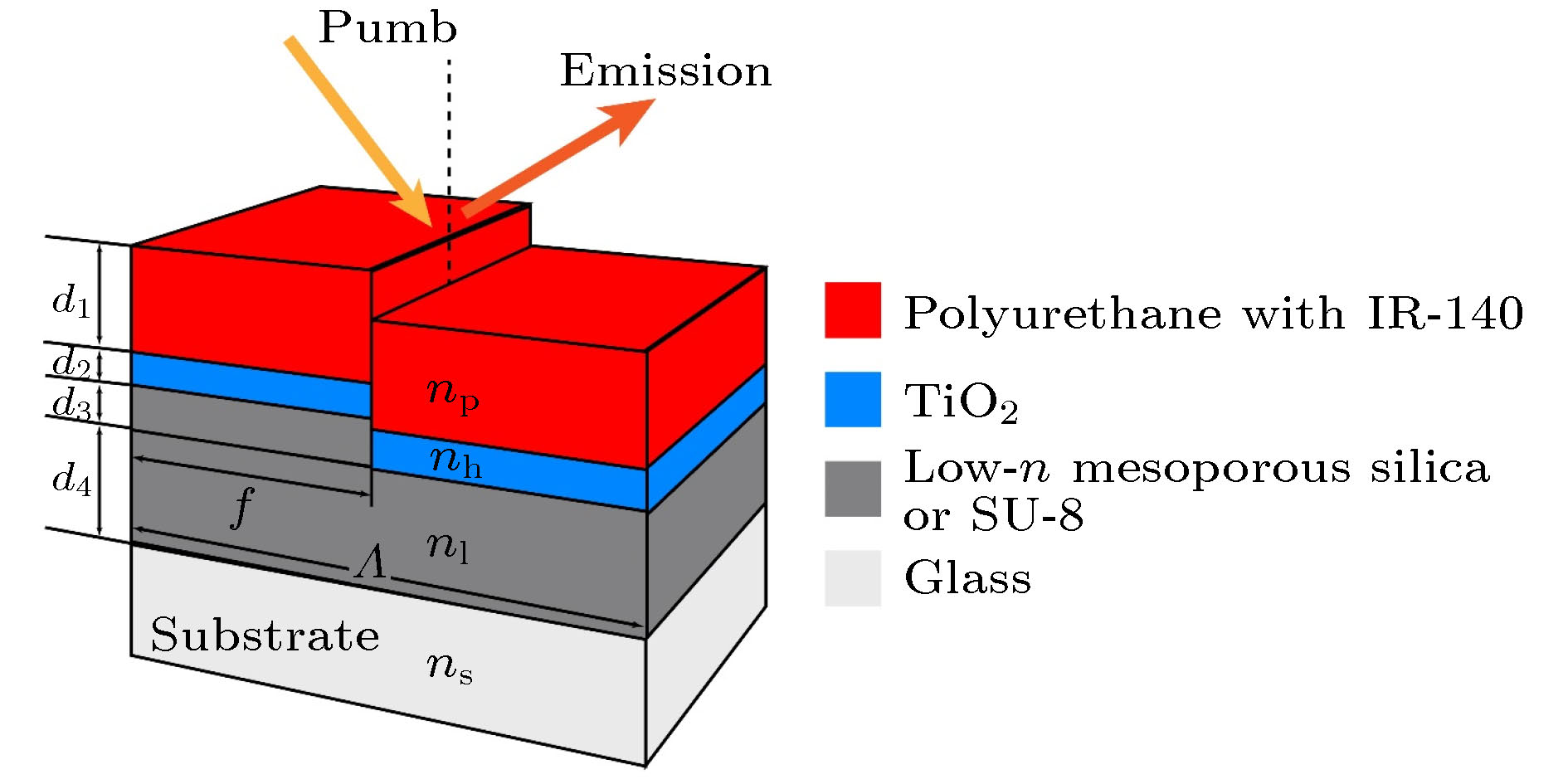
 下载:
下载:
